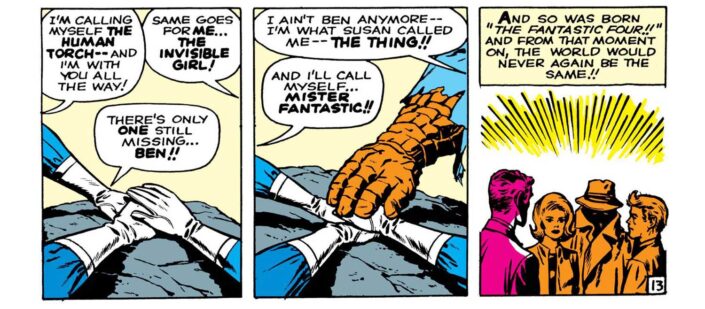
Marvel’s First Family is making her first steps (again) this summer on the big screen with a new adaptation set in the Marvel Cinematic Universe. While the MCU officially launched in 2008 with Iron Man, the Fantastic Four laid the groundwork for the Marvel Comics we know today.
Now is a good time to take a look back at the debut of the Fabulous Foursome in The Fantastic Four #1, which hit the shelves on August 8, 1961—64 years ago.

A classic among pulp fiction and comic books, the cover of Fantastic Four vividly shows a monster rising from the ground and grabbing a young woman. This is no ordinary woman but the Invisible Girl, a member of the Fantastic Four! The Thing, Human Torch, and Mister Fantastic are all present, ready to fight the creature in this iconic comic book issue.
The 25-page story tells the origin of the Fantastic Four as would-be astronauts bombarded with cosmic rays, which transform them and grant superpowers that will quickly be put to use to fight the Mole Man.
The famous team was created by Stan Lee and Jack Kirby, responding to Martin Goodman’s request for a Marvel version of the Justice League of America. As Stan Lee recalled in a interview from 2006:
[Goodman] had found out that our competitor, DC Comics — which called itself National Comics in those days — they had done a book called The Justice League of America — a group of superheroes — and it was selling very well. And he said to me: ‘Stan, why don’t you do a book about a group of superheroes’. So I figured this is my chance to do it my way. So I came up with something I called The Fantastic Four about four superheroes, but instead of making them heroes who wore costumes I figured, I’m not going to give them costumes, ’cause I always felt if I had a superpower, why would I want to put on a costume? First of all, I’m too much of a show off. I’d want everybody to know it’s me I would never wear a mask. And why would I need a costume? If I could jump over a building, I don’t have to wear a colorful costume I’ll just jump over the building. At any rate, I didn’t give them costumes and I tried to make them real characters living in the real world.
Not wearing a costume wasn’t the first specific element that made the Fantastic Four stand out from the crowd. Lee’s approach to try to “keep everything as realistic as possible, even though it was just a comic… superhero comic, ” highlighting the characters’s quality and default, showing them fighting among each others and living in New York City played a role in defining the Fantastic Four and changing the shape of the superhero comic of the time.

The Famous Foursome wouldn’t have so much success without Jack Kirby’s iconic and dynamic artwork. This was particularly crucial in the early days when Stan Lee was still searching for clear voices of the characters and struggled with uninspired or silly dialogue. And if you listen to Kirby, the Fantastic Four might not have come into existence if it weren’t for him, as he explained in an interview with Leonard Pitts in 1986-1987:
The idea for the F.F. was my idea. My own anger against radiation. Radiation was the big subject at that time, because we still don’t know what radiation can do to people. It can be beneficial, it can be very harmful. In the case of Ben Grimm, Ben Grimm was a college man, he was a World War II flyer. He was everything that was good in America. And radiation made a monster out of him–made an angry monster out of him, because of his own frustration.
If you had to see yourself in the mirror, and the Thing looked back at you, you’d feel frustrated. Let’s say you’d feel alienated from the rest of the species. Of course, radiation had the effect on all of the F.F.– the girl became invisible, Reed became very plastic. And of course, the Human Torch, which was created by Carl Burgos, was thrown in for good measure, to help the entertainment value.
Like Action Comics #1, which is considered the beginning of the superhero genre, reading Fantastic Four #1 is also reading a page of comic book history, discovering where the Marvel Comic Book Universe started and redefining the superhero genre at the same time.
![]()